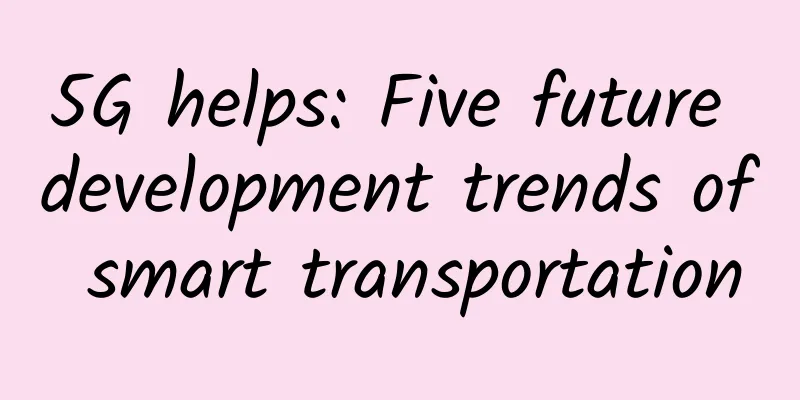5G helps: Five future development trends of smart transportation

|
According to relevant research reports, the global transportation system will enter a rapid development stage starting from 2020, with both connectivity and networking greatly improved compared to the past. Globally, we see more and more transportation management authorities working with transportation companies, partners, and technology companies to make a lot of attempts for the development of "smart transportation" and have achieved good results.
In addition, the deployment of 5G will also accelerate significantly in 2020. According to the latest research report "5G Deployment Status" released by VIAVI, as of January 2020, 378 cities in 34 countries around the world have deployed commercial 5G networks. This will also help promote the development of intelligent transportation. 5G networks mainly bring faster and more stable network connections to intelligent transportation, which is crucial to the development of intelligent transportation. Image source: VIAVI "5G Deployment Status" research report Technological innovation is changing transportation systems and networks, and constantly improving our transportation and travel experience. According to Deloitte, by 2040, 80% of urban travel around the world will be achieved through shared autonomous vehicles. So, how will leaders in the transportation industry keep up with the times and build a sustainable and intelligent transportation system? The World Economic Forum (WEF) recently released a report outlining how transportation leaders can reshape the industry. Recommendations include establishing innovative strategic partnerships, technological breakthroughs and new technology applications, improving project management and asset management, and enhancing user experience. Globally, many cities have already started to take action. For example, Singapore has developed the Land Transport Master Plan for 2040, which details its policy to make public transport the preferred mode of transport, with an expectation that the proportion of public transport used during all peak hours will increase to more than 90% in the future. In addition to some suggestions from the World Economic Forum, the following five trends may become the key directions for the future development of intelligent transportation. 1. Wireless connectivity makes commuting time more valuable According to social survey statistics, people in big cities now spend far more than an hour commuting every day. For example, in global cities such as New York, Sydney and London, the average weekday commuting time is more than 80 minutes, while in Toronto it is more than 1.5 hours. On average, people spend about 6.5 hours on their way to work each week, which is almost equal to a full workday. In China, especially in first-tier cities such as Beijing, Shanghai, Guangzhou and Shenzhen, it is not uncommon for most office workers to commute for more than three hours a day. Therefore, how to fully utilize and take advantage of such a long commuting time based on the application of new technologies will have huge economic benefits for social development. Whether taking public transportation or traveling by smart Internet car, the smart transportation network allows people to use their time more efficiently on the way to work. Whether it is mobile office, learning or keeping in touch with family and friends, it is contributing to economic development. Starting from 2020, with the deployment and implementation of 5G networks, superior network connectivity performance will provide better opportunities for consumers and businesses, bringing about tremendous changes in people’s working hours, career development, and lifestyle choices. 2. Networked trains/high-speed trains are becoming more common Today, passengers' expectations for public transportation are no longer limited to getting from point A to point B. They also expect rail networks to provide high-speed, stable wireless connections. In a global poll, when asked what makes a city smarter, innovative transportation systems (including features such as "smart bus stops" and "intelligent transportation systems") ranked high. Therefore, rail transportation systems need to provide simple, stable, reliable and secure online connection services. In China, we have seen that more and more high-speed trains have begun to provide free WiFi network services. Although the current experience is not satisfactory, railway WiFi will soon become a standard service. There are currently two main ways to provide wireless network connectivity services to passengers on trains: dedicated networks beside the track, and dedicated onboard devices combined with existing cellular networks. As for which method to choose, decision makers need to first consider factors such as passenger demand, cost and partners. In addition, factors such as existing cellular infrastructure, passenger flow density and expected expansion use need to be considered. But no matter which method they choose, passengers hope to be able to enjoy high-speed, stable and secure network connection services without any obstruction. 3. Superior network connection creates more value In addition to improving the user experience, superior network connectivity can also bring significant operational and safety advantages to transportation management authorities. The application of 5G high-speed networks enables real-time data from fast-moving trains and Internet sensors to be transmitted to the control center in the first place, facilitating the optimization of services and the improvement of safety measures. For example, real-time video surveillance supports facial recognition and behavioral analysis, which improves safety. When an emergency occurs, managers can respond quickly and quickly coordinate station or train staff to deal with it on the spot as soon as possible. With IoT-connected sensors, security personnel can monitor the operation of traffic equipment and the vehicle itself in real time, such as monitoring doors, brakes, wheels, and cooling systems, etc. Necessary replacements or maintenance can be carried out in advance, which can reduce the probability of major failures and optimize the efficiency of fleet use. In addition, wireless connectivity can further improve train punctuality and better implement pick-up services. Therefore, real-time service data updates, rapid response to events, and other data collection and analysis can help authorities reduce costs and improve operations and passenger services. 4. Smart cities In order to make urban life better, we increasingly need a smarter city. This also means that our cities need to accumulate more "intelligent" infrastructure so that we can collect basic data on urban operations from connected devices, platforms and networks, and then conduct big data analysis and make correct decisions, thereby improving the management level of urban development. With the acceleration of urbanization and the rapid development of technology, how to make more correct decisions has brought great challenges to urban managers. Economic development and social transformation can also provide people with better opportunities to participate in and contribute to the sustainable development of cities. 5. People-oriented Ultimately, the operational advantages brought by connectivity will benefit everyone by providing safer and more efficient services. As the global energy crisis worsens, governments around the world are vigorously advocating green travel and encouraging citizens to travel by public transportation. Passenger experience is a key factor in the competitiveness of urban public transportation compared to other travel options (for example, driving or shared travel services). Public transportation experts point out that technological innovation brings more expectations: "In addition to safety and reliability, passengers are increasingly looking forward to better transportation facilities, such as good lighting, safe and reliable wireless connections, etc." If the overall experience is not good, then passengers will choose other means of transportation. Today's concepts will be tomorrow's solutions A true intelligent transportation system is how stakeholders and decision makers use these technological advances to improve people's lives. "Intelligence" is the main feature of innovative transportation systems, and we need continuous connection and innovation to achieve a better life in the city of the future. Our expectations for various innovative "concepts" of intelligent transportation systems today are actually tomorrow's solutions. |
<<: How the Convergence of IoT and 5G Will Shape the Construction Industry
Recommend
Interview blitz: Is TCP reliable? Why?
Author | Lei Ge Source | Java interview questions...
Don’t worry anymore! Teach you how to quickly locate Eth-Trunk faults and easily solve network problems!
1. How to locate the problem that an Eth-Trunk in...
JustVPS: 30% off UK VPS/20% off all VPS, unlimited traffic in multiple data centers in the United States/France/Singapore/Russia/Hong Kong, China
JustVPS.pro bought a VPS in London, UK, last Dece...
[Black Friday] DMIT consumption rebate, 20% off Japan VPS, 50% free traffic in Hong Kong/Los Angeles
DMIT.io also launched a promotion during Black Fr...
In 2017, the industry cloud finally became a big thing. It is not as simple as cloud + industry!
A reporter once asked many industry customers a q...
OneTechCloud adds 1Gbps high-bandwidth VPS in Hong Kong, 20% off monthly payment starting from NT$52
OneTechCloud has recently added Hong Kong Interna...
6G network speed greatly improved, Chinese team set a new record of terahertz 100Gbps transmission
5G network technology has increased the speed of ...
Academician Wu Hequan: "Spectrum Blockchain" can be used to solve the 5G spectrum shortage problem
At the 2020 China Radio Conference which opened y...
Biyouxue: Solve growing pains with software development cloud
Education is an eternal research topic, and its i...
Have you used 5G? Wang Jianzhou: 6G network will be commercially available in 2030
According to Sina Technology, at the 2021 Technol...
VMISS 30% off, starting from $2.6/month, Hong Kong/Japan/Korea/Los Angeles CN2 GIA/AS9929/CMIN2 and other computer rooms
VMISS (Virtual Machines Innovative Solutions) was...
Building the future of intelligent networks at the edge
Edge computing is evolving and is the future of b...
Five ways edge computing drives digital business
Every industry has created a new normal: if your ...
Fast, intelligent, and secure cloud application delivery is the new trend in 2017! F5 invites you to start a more free cross-cloud journey
[51CTO.com original article] Cloud computing has ...
Pan-Sahara fiber optic backbone network receives RMB 320 million in financing from AfDB
[[179783]] The African Development Bank has recen...









